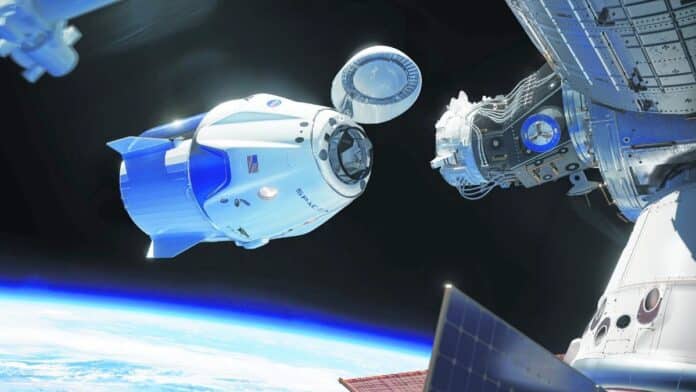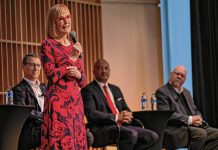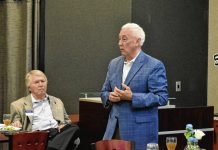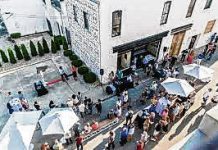
A local retired engineer is helping amateur radio operators and students connect to the International Space Station.
For Ed Krome of Columbus, engineering has been a lifelong passion.
When he was 21, he built a Meyers Manx dune buggy. In 1963, he got his amateur radio license (though he prefers experimenting to chatting with other ham operators). For many years, he was the engineering manager for Master Power Transmission. In his own words, Krome holds “nine patents on mechanical devices” and has built “everything from micro-electronics to a two-story house.”
Now, the retired electrical and mechanical engineer is wrapping up work on something a little more interstellar — a power supply for shortwave radio equipment on the International Space Station.
[sc:text-divider text-divider-title=”Story continues below gallery” ]
For more than two and a half years, Krome has been a mechanical engineer and designer on a Multi-Voltage Power Supply (MVPS) that is part of an Interoperable Radio System.
On March 6, Krome, along with the rest of the power supply team, was invited to watch the first MVPS’s launch into space at Cape Canaveral. The power supply was aboard the SpaceX CRS-20.
“It was the clearest night ever,” Krome said. “And you could see everything. You know, we saw the launch, we saw the first stage cutoff, we saw the separation, we saw the booster come back down and land only about a mile from us. And it was just spectacular.”
The power supply is used by an international organization known as Amateur Radio on the International Space Station (ARISS).
The organization helps young people learn about STEM and space by connecting astronauts on the International Space Station with students on the ground.
“The amateur radio operators on the ground are the go-between between the signals coming down and going to the space station and the students,” Krome explained.
Every year, schools can apply to host “contact events,” where students have about 10 minutes to talk to astronauts on the space station and ask questions. Once a school is chosen, Krome said, there is a contest where third through 10th graders submit questions to ask the astronauts. The top 10 or 12 questions will be selected and sent to the ISS in advance, in case the astronauts need to research the topic.
“When the space station comes overhead, and it’s only visible for 10 or 12 minutes at a time, they make the contact with the space station,” Krome said. “And then the student who wrote the question gets to get on the microphone and ask his question to the astronaut.”
Krome said these contact events often involve not just entire schools listening in, but entire communities. Last year, there were 77 contact events and more than 80,000 people were listening in, which Krome called “a typical year.”
“There haven’t been any in-person contacts lately with all schools worldwide shut down, but there have been a few experiments using Zoom,” he said of the project continuing during the pandemic.
Krome became involved with ARISS more than two and a half years ago.
“I was recruited by the project manager (who is an old friend) who said that they needed an ‘experienced mechanical engineer and designer’ and the project was ‘only a power supply,’” Krome recalled. “That was an understatement.”
Krome said that the original mechanical design on the project was done by a professional satellite designer who left after a year and a half of working on the project.
“He did the basic design and then handed it off to me and said, ‘Here, complete it and make it work,’” Krome said. “So my work not only included the design, but I built up an automated test arrangement to investigate the temperature and noise requirements.” He also bought and assembled mechanical parts in his home before shipping them off to California for final assembly.
Krome said that the MVPS was needed to replace old equipment.
“So what this power supply is, it replaces the power supplies for these transceivers, these radios, that have been on the space station,” he explained. The power supplies also provide power to television-related experiments as well.
However, this equipment is more than a new power supply; it’s a major milestone for volunteer equipment on the ISS.
“It’s the first piece of equipment that has ever gone to the space station that was 100% built and managed by volunteers,” Krome said. “Anytime that you deal with space, there are a lot of rules and regulations, and everything is safety-related. So the documentation and the testing becomes extreme. So there are companies that actually do that kind of documentation, but you pay them to do that. Well, this one, we didn’t pay anybody. We did it all with our group.”
Once the power supply was built and Krome had conducted his tests, the electrical designer also had to take the unit to the NASA Johnson Space Center for rigorous testing before it could be sent to the ISS.
The new Multi-Voltage Power Supply is also unique in that it can be used anywhere on the space station.
“This was not possible with any equipment for this activity before, as voltages are different on different parts of ISS (the space station),” Krome said.
Krome said that he’s currently finishing up work on the MVPS project, which includes building cables for a diplexer, and the group working on the project still meets for weekly teleconferences.
He also said that there are three more power supplies that are “manifested to launch” in the future (one will go to the American section of the ISS, the other two will go to the Russian section) and six units that are “designated for training and other uses.”
“We’re still quite involved in this,” he said. “And the electrical designer who’s doing the final assembly. … I worked with the fellow in San Diego for two and a half years, every week and sometimes more than that, and I’d never met him. So I finally met him at the launch in Canaveral.” The electrical designer is Kerry Banke, a retired electrical engineer.
When asked what was the best part of the project was, Krome replied, “It’s just exciting and interesting. It’s new technology, it’s space-related. It’s STEM, you know, it’s trying to get the next generation, or two generations from now, interested in science, technology, engineering and mathematics. You know, and in this, the current political environment, where science and mathematics are not stressed, I think that we need to do all that we can to get kids interested in this stuff, because we need good engineers and scientists and mathematicians. … That’s what this is all about, is getting kids interested in it.”
[sc:pullout-title pullout-title=”Where to learn more” ][sc:pullout-text-begin]
Amateur Radio on the International Space Station (ARISS) receives funding from and uses resources of the International Space Station U.S. National Laboratory. ARISS is a member of the Space Station Explorers consortium.
ARISS is a cooperative venture of international amateur radio societies and the space agencies that support the International Space Station (ISS). In the United States, sponsors are the Radio Amateur Satellite Corporation (AMSAT), the American Radio Relay League (ARRL), the International Space Station U.S. National Laboratory and National Aeronautics and Space Administration (NASA).
The primary goal of ARISS is to promote exploration of science, technology, engineering, and mathematics (STEM) topics by organizing scheduled contacts via amateur radio between crew members aboard the ISS and students in classrooms or public forms. Before and during these radio contacts, students, educators, parents, and communities learn about space, space technologies, and amateur radio. For more information, see www.ariss.org.
Information on contact events and how to host one can be found at https://www.ariss.org/submit-a-contact-proposal.html.
[sc:pullout-text-end]




